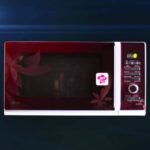- How to test cookware for suitability for microwave use
- Dishes from which materials can not be used categorically
- What materials are suitable for microwave ovens
- More about plastic containers
- About whether it is possible to cover plates during heating
- What should be the capacity for cooking and baking in the microwave
A microwave is a convenient thing, no doubt. Now, probably, no kitchen can do without it. But, oddly enough, some still do not know which dishes can be used in the microwave, and which not. And these people are incredibly surprised when they hear a loud explosion inside the chamber ...
How to test cookware for suitability for microwave use
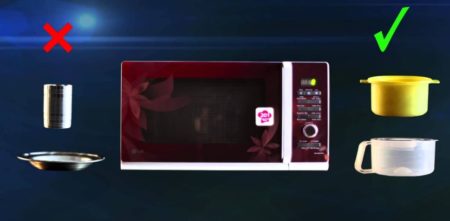
If you have never used any utensils available in your home in a microwave oven, we recommend that you check them first. Because, the dishes may look quite suitable, but in practice, it will take and burst during the heating process! And even in your hands, when you start to get a hot plate with borsch, which is much more unpleasant.
Take an ordinary faceted glass (or, any cup in which you heated the liquid before and did not observe any adventures), fill it by a third with water. And place it on the plate you want to test. Run normal warm-up mode for 1 minute.
If the capacity is suitable, then at the end of the process you will find that the liquid in the glass has warmed up, or even boiled, but the test plate remained completely cold. If, however, it is hot, then you should not use it, it is not for the microwave, obviously.
But, you can check what is already available. In a store, such a trick will not work. Therefore, you need to know in advance, at least in theory, what to look for when buying microwave ovenware.
See also:
- 5 of the best LG microwaves of the year
- 5 best microwaves Daewoo Electronics
- The 5 best Panasonic microwaves
- 6 Best Horizont Microwaves of the year
- 6 Best BBK Microwave Ovens
- 6 of the best Korting microwaves
Dishes from what materials cannot be used categorically
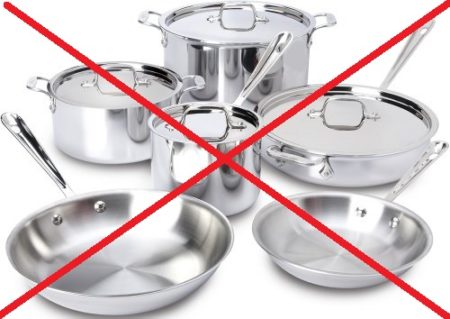
And now, let's get more details on which dishes should not be put in the microwave. Remember once and for all that the most unsafe microwave materials are:
- Crystal
- Thin glass or melamine
- Clay and ceramics without glaze
These three materials burst shamelessly when exposed to microwaves. Crystal contains lead, and, moreover, has a non-uniform texture. Clay also, if not protected by dense glaze, is heterogeneous and full of internal bubbles that are invisible externally. When heated, these cavities are bursting, and you, opening the door, find a sad handful of fragments.
But, we repeat: it is good if this happens inside, right in the process, and not in your hands. So these two materials are the most inappropriate.And, if about crystal glass, and so it is clear, and there’s nothing much to warm in it, then clay plates and glasses made of thin glass are often put in microwave ovens.
The rest of the dishes that are not suitable for microwave ovens will hit the oven, not your hands. But why tempt fate and disable equipment? The materials listed below cause sparks, crackling and popping inside the chamber:
- Copper
- Brass
- Cast iron
- Steel
- Gold plating
- Metal coating
It is clear that you need to forget about saucers with a golden border. But, what’s interesting is that there are drawings that look like the most ordinary paint, but in fact contain a lot of metal, which causes an electric discharge. Therefore, you need to take plates without a pattern at all.
![]() See also - How the microwave works
See also - How the microwave works
What materials are suitable for microwave ovens
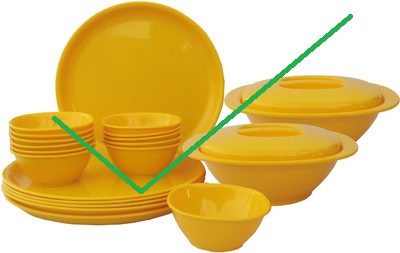
In the first place on this list - glass, heat-resistant dishes. She is not afraid of anything, the food in it is perfectly warmed up, she herself remains cold, and the stove consumes much less electric energy than when using other materials.
But, a huge minus of these dishes is their high cost. It costs three to four times more than usual. And to purchase it in sufficient quantities for the whole family is not available to everyone.
Also, porcelain and earthenware dishes are suitable for use, of course, without drawings. Ceramics are also suitable if they are covered with a uniform glaze layer. Plastic, polyethylene, paper dishes, silicone, parchment paper, and even linen or cotton cloth are also suitable (you can heat bread on it, for example).
Glass is quite suitable, but not thin, but as thick as in ordinary cans or a faceted glass.
We draw your attention to the fact that you should not use any dishes on which the glaze is partially applied. She warms the food unevenly and, again, may burst.
More about plastic containers
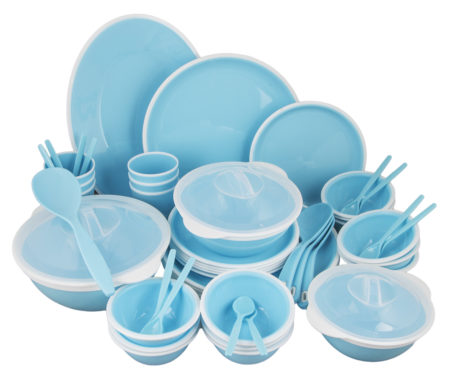
With plastic, everything is simple: on the label of such containers, there must be a marking whether it is suitable for microwave ovens, whether it can be suitable for heating or not. But, it's in the store, of course.
But what if you have a sudochka, and there are no stickers on it for a long time? Then, you better not use this cookware, since if it turns out that this material is not intended for microwave, then, when heated, it will release a lot of harmful substances that will go directly into food.
It is easier to go to the store and buy a new vessel, which you will be sure of. Most importantly, do not take the cheap one that came from Shanghai. These enterprising people will write you whatever you want and put any markings you want, but in fact, the material, as it was, will remain unsuitable for high temperatures. And not only is heating in the microwave itself not very useful, but coupled with Chinese plastic, it will just be a huge blow to the liver.
Although, by and large, what kind of need to heat food in them? There are of them quite unsympathetic.
About whether it is possible to cover plates during heating
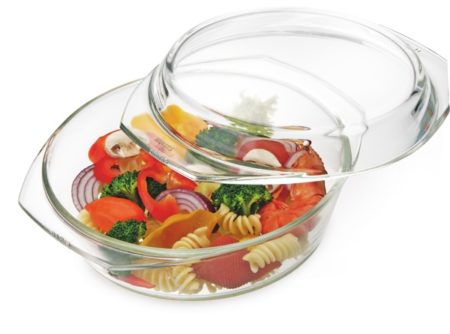
It is impossible to cover tightly, it will explode. No wrapped pans and plates are needed. Heating an open container is not an option either. For example, after warming up buckwheat porridge with liver, the walls of the microwave will have to be scrubbed for a long time and tediously, since these products explode from the inside by themselves.
The best option is special covers, which are sold in home appliance stores. They are very large, the size of a rotating circle of the stove, and their height is also large. I put a plate under this flask - and no problem! It warms up, does not explode, and does not slam the walls.
Although, using them you need to know: they do not withstand strong boiling of products. Then they are compressed due to the fact that a vacuum is formed and tightly stick to the glass circle. Just because they can’t be removed, you will need to pry it with a knife from below to give air access.
Choosing the best form for warming up
Not only the material, but also the shape of the cookware is important for comfortably heating food. The microwave heats up quickly and often, the liquid splashes out.The best modification of plates or cups for microwave - with an expanding top. In them, for some reason, the liquid behaves calmly, even if it boils heavily.
What should be the capacity for cooking and baking in the microwave
Separately, I would like to talk about what kind of dishes you can cook in the microwave.
Cooking and stewing is possible only with refractory glassware. There is nothing better and cannot be. But, it should be borne in mind that the microwave, as we wrote above, has the property of pushing the liquid out. Therefore, choose a larger capacity, and not end-to-end. Food and water should be up to 2/3 of the total volume.
The same goes for baking. Either choose a larger shape, or put a little less dough than when baking in a conventional oven. The ideal material for this is silicone.
Now you know exactly what utensils can be used in the microwave. We wish you all the best and fewer surprises with fireworks!
See also:

